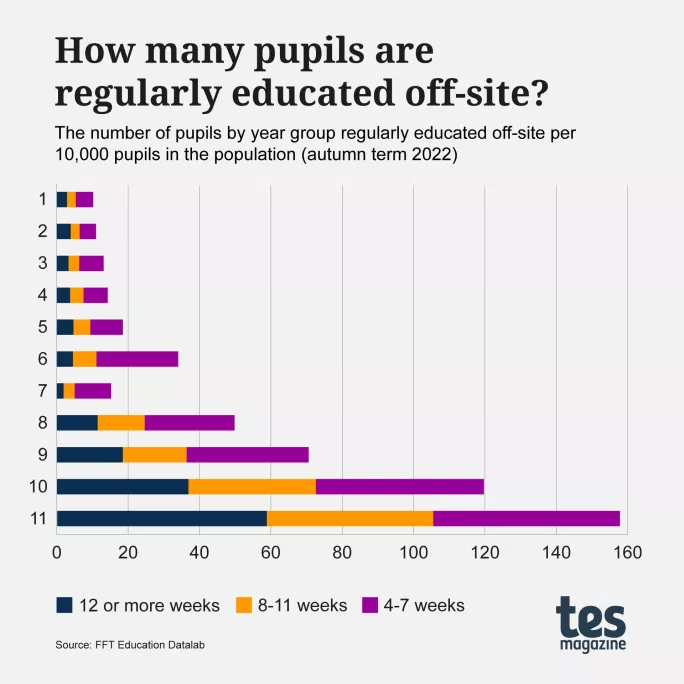Revealed: the number of pupils educated off-site

More than 30,000 pupils were regularly sent to provision off school sites last term, a new analysis suggests, amid government concern about where students categorised by schools as taking part in learning activities off-site are being educated.
New figures on schools’ use of the B attendance code - for pupils who are classed as present but who are being educated off-site - have been published by FFT Education Datalab after children’s commissioner Dame Rachel de Souza raised concern about the use of the code with MPs.
Its analysis also comes after Tes revealed that the Department for Education has concerns about the education children are receiving when they are recorded as being present by schools with this code.
- Off-site schooling: DfE concern about use of the B code
- Background: Children’s commissioner raises fears over B code use
- School attendance: Education committee launches inquiry into persistent absence
A blogpost by FFT’s chief statistician, Dave Thomson, reveals new data about the use of this code in the autumn term, from more than 10,000 schools that subscribe to the FFT Attendance Tracker.
FFT has identified pupils who are regularly educated off-site and recorded using the B code by calculating the number of weeks in which pupils are educated off-site for at least one half-day session.
Those who were educated off-site for four weeks or more were considered to be regularly educated off-site.
Year 11 has highest rate of off-site schooling
The data shows that the number of pupils being regularly educated off-site increased as the age ranges went up.
The highest proportion was in Year 11, in which 158 in every 10,000 students (1.58 per cent) were regularly educated off-site last term.
Rates among other year groups, particularly primary phase age groups, were much lower, the FFT analysis shows.

The data does show that more pupils were regularly off-site in Year 6, in their final year of primary school, than in Year 7, in their first year of secondary.
Mr Thomson says: “Scaling these figures up to the full national population of pupils, we would estimate that around 33,000 pupils would have been regularly educated off-site last term. This is out of a population of over 7 million.
“In other words, it is rare for pupils to be regularly educated off-site, at least over the course of one term. What we don’t know is whether this is any different to the situation pre-pandemic.”
Pupils with SEND more likely to be off-site
Pupils with special educational needs and disabilities (SEND), particularly those with education, health and care plans (EHCPs), were more likely to be educated off-site than their peers, accroding to the FFT analysis.
It shows that 6 per cent of pupils with EHCPs were regularly educated off-site last term.
The research also reveals that pupils who were identified as being regularly educated off-site had spent more time being educated off-site than attending the school at which they were registered.
For these pupils, 35 per cent of sessions were spent off-site compared with 33 per cent at school.
And just over 10 per cent of sessions for these pupils were missed through unauthorised absence.
Some pupils not in school all term
Almost a quarter of the pupils who were regularly educated off-site “did not attend a single session at the school at which they were registered”, the FFT Datalab analysis shows.
There was also a concentration of pupils being regularly educated off-site at a small proportion of schools.
Just over three-quarters of the secondary schools using FFT’s Attendance Tracker had at least one student regularly educated off-site. However, its analysis also shows that 40 per cent of pupils being regularly educated off-site attended 10 per cent of the schools.
In the blog, Mr Thomson says: “Typically between 2 per cent and 5 per cent of pupils at each of these schools were regularly educated off-site.”
Where are B code children going?
The B code is not meant to include pupils who are dual registered, undertaking work experience, attending interviews, going on visits on trips or engaging in sporting activities, as these are covered by separate codes.
At last week’s meeting of the Commons Education Select Committee, Dame Rachel raised concerns that the code might be being used by schools in cases where pupils have been sent home to learn.
Tes understands that the DfE is concerned about the quality and oversight of both online schools and unregistered alternative provision that pupils are accessing when the B code is used in some cases.
In the FFT blog, Mr Thomson says: “Clearly, the schools of pupils undertaking off-site provision will know what they are doing. But for those not working in schools, particularly those involved in policy, what they are doing is something of a mystery.”
He suggests that the DfE could use its data to investigate whether pupils are attending other schools, including state-funded alternative provision schools, attending FE colleges or attending unregistered alternative provision or provision in the independent sector.
You need a Tes subscription to read this article
Subscribe now to read this article and get other subscriber-only content:
- Unlimited access to all Tes magazine content
- Exclusive subscriber-only stories
- Award-winning email newsletters
Already a subscriber? Log in
You need a subscription to read this article
Subscribe now to read this article and get other subscriber-only content, including:
- Unlimited access to all Tes magazine content
- Exclusive subscriber-only stories
- Award-winning email newsletters
topics in this article



